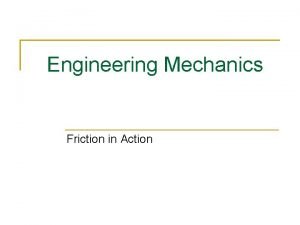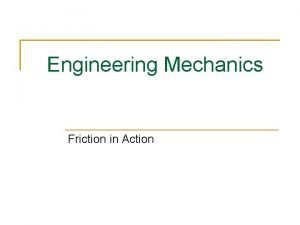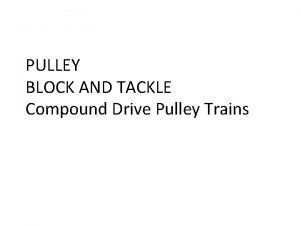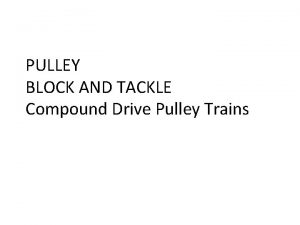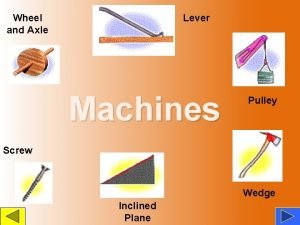The Wedge and The Pulley A wedge is









- Slides: 9

The Wedge and The Pulley

� A wedge is really an inclined plane turned � But instead of helping you move things to on its side. a higher level, a wedge helps you push things apart. � The blades of a knife or a shovel are both wedges. � A wedge can also be round, like the tip of a nail, or the tines on your fork. � Basically, the wedge works just like a ramp: The narrower the wedge (or the sharper the point of a wedge), the easier it is drive it in and push things apart. But here's the trade-off: � To split something apart really wide, you have to push the wedge a long distance. The Wedge

�There are two major differences between inclined planes and wedges. First, in use, an inclined plane remains stationary while the wedge moves. Second, the effort force is applied parallel to the slope of an inclined plane, while the effort force is applied perpendicular to the direction of travel when using a wedge. The Wedge

�A wedge can either be composed of one or two inclined planes. A double wedge can be thought of as two inclined planes joined together with their sloping surfaces outward. Single and double wedges are illustrated below: � � � Double Wedge Single Wedge A common example of single wedge is a simple door stop or a wheel block. Though the "person holding the door" below is unique and entertaining, its forward foot is nothing more than a wedge. The Wedge

A common example of single wedge is a simple door stop or a wheel block. Though the "person holding the door" below is unique and entertaining, its forward foot is nothing more than a wedge. � Single and double wedges are often used in the timber industry where they aid in the felling of trees and splitting of wood. Note in the first picture below that when the wedge (an ax is nothing more than a double wedge fixed to the end of a handle) moves downward, the work it does is in splitting the log sideways (i. e. perpendicular to the direction of force). The railroad engine on the right uses a rather large wedge to plow snow off of railroad tracks, and in this case works both forward and backward. � The mechanical advantage of a wedge can be found by dividing the length of the slope (S) by the thickness (T) of the big end. As an example, assume that the length of the slope is 20 cm and the thickness is 5 cm. The mechanical advantage is equal to 20/5 = 4. As with the inclined plane, the mechanical advantage gained by using a wedge requires a corresponding increase in effort distance. In this case for every 20 cm you drive the wedge you spread the log 5 cm. � The Wedge

�Which of these wedges has the greatest mechanical advantage? The Wedge

� If you picked A you are correct. Since A is "sharper", it will be easier to drive into the log. However, it may not have enough "pushing" ability to split the log. Wedge B would be much harder to drive into the log, but it clearly has more capability for splitting the log due to its greater thickness at the top. � The wedge on the right has the best of both worlds due to its wedge-within-a-wedge design. It starts out with a long thin slope then, once the tip gets things started, the broader top wedge helps to push things apart. (note the same property on the axe. ) � If you have a wedge doorstop, have your students determine its mechanical advantage. If you really want to get tricky, try to calculate the mechanical advantage of a butter-knife blade. The Wedge

� The pulley is really a wheel and axle with a rope or chain attached. � A pulley makes work seem easier because it changes the direction of motion to work with gravity. � Let's say you have to lift a heavy load, like a bale of hay, up to the second floor of a barn. � You could tie a rope to the bale of hay, stand on the second floor, and pull it straight up. � Or you could put a pulley at the second floor, stand at the first floor, and lift the bale of hay by pulling straight down. � It would be the exact amount of work in either case, but the action of pulling down feels easier because you're working with the force of gravity. The Pulley

�A pulley really saves effort when you have more than one pulley working together. � By looping a rope around two, three, or even four pulleys, you can really cut down on the effort needed to lift something. � The trade-off? Well, as you increase the number of pulleys, you also increase the distance you have to pull the rope. � In other words, if you use two pulleys, it takes half the effort to lift something, but you have to pull the rope twice as far. � Three pulleys will result in one-third the effort — but the distance you have to pull the rope is tripled! The Pulley

